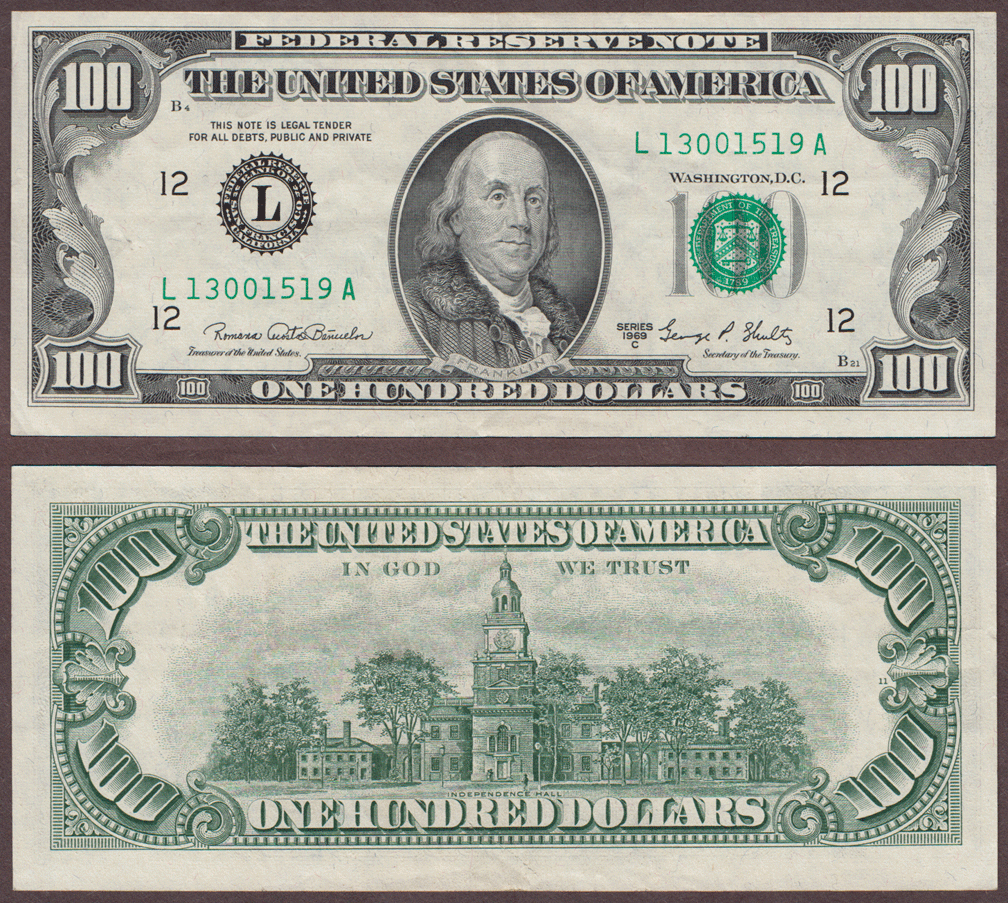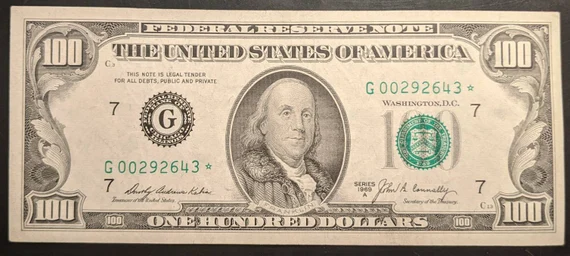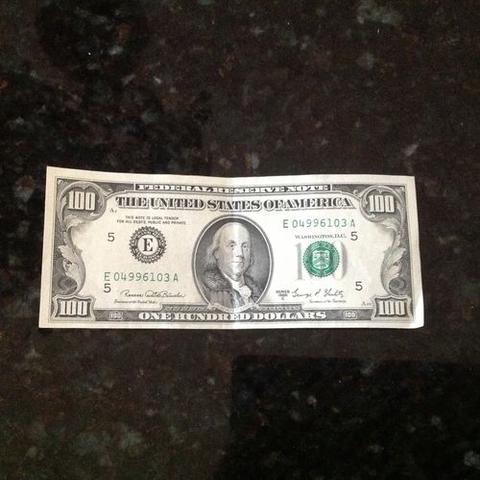The 1969 100 dollar bill value is a topic that interests many collectors and enthusiasts of paper money. While most of the 1969 series $100 bill notes are not significantly valuable, there are specific factors and types that can make these bills worth far more than their face value.
Understanding the value of these historical bills requires knowing the series they belong to, their condition, and any rare variations like star notes or error notes.
In this article, we will explore the key aspects that contribute to the 1969 one hundred dollar bill’s value, including its specifications, how to identify star notes, and tips on grading and assessing the worth of these old bills.

This guide will provide insight into how much a 100 dollar bill from 1969 might be worth today.
Specifications Of The 1969 $100 Bill
The 1969 $100 bill is part of the Federal Reserve Note series, with portraits of Benjamin Franklin featured prominently.
These bills were issued under several different series during 1969, namely the 1969, 1969A, and 1969C series. Each series features slight differences in design and can affect the overall value of the note.
The $100 bill has the following specifications:
- Denomination: $100 USD
- Type: Federal Reserve Note
- Portrait: Benjamin Franklin
- Series: 1969, 1969A, and 1969C
The 1969 series bills have become a noteworthy part of currency history, and knowing the series of your bill is essential to determining its worth.
1969 series bills were printed with different Federal Reserve banks, and some of these notes are rarer than others, especially those that were issued as replacement notes, commonly known as star notes.
General Value Of The 1969 100 Dollar Bill
In most cases, the 1969 $100 bill is worth no more than its face value of $100 if it is in circulated condition. Bills that have been used in everyday transactions show signs of wear, such as creases, folds, and possible discoloration. These conditions can lower their value in the collector’s market.
For example, a one hundred dollar bill in worn condition typically won’t sell for much more than $100.

However, there are exceptions, particularly when the bill is in pristine, uncirculated condition. A 1969 $100 bill that has never been in circulation and is in uncirculated condition can be worth much more.
An MS 63 grade uncirculated bill from any of the 1969 series is generally valued around $175. The 1969A and 1969C series notes, especially in uncirculated condition, can fetch similar prices, with star notes offering even greater potential value.
Star Notes and Their Value
One of the key factors that can affect the 1969 100 dollar bill value is whether the bill is a star note. Star notes are replacement bills that the United States Federal Reserve printed to replace misprinted or damaged currency. These bills are rarer than regular notes because they were produced in smaller quantities.
To identify a star note, simply look at the serial number on the bill. If the last character of the serial number is a star symbol, it signifies that the bill is a star note. Because of their rarity, star notes tend to be more valuable than their regular counterparts.
For example, the 1969 series $100 star notes can be worth around $175 in extremely fine condition. In uncirculated condition, the value of these notes can rise significantly, ranging between $275 and $350, depending on their grade and rarity.
Similarly, 1969A series $100 star notes can fetch about $185 in extremely fine condition, with uncirculated examples reaching approximately $275.
Series Variations and Bank-Specific Values
Different issuing banks also play a role in determining the value of a 1969 one hundred dollar bill. For instance, star notes issued from certain Federal Reserve Banks tend to be worth more than those issued from others.
The 1969C series is particularly notable for these variations.
The common 1969C series $100 star notes, issued by the Federal Reserve Banks of Chicago and San Francisco, typically range in value from around $125 in extremely fine condition to $275 to $325 for uncirculated notes with an MS 63 grade.
However, star notes from other banks, such as Atlanta and St. Louis, are much rarer and may command higher prices, potentially reaching $375 to $450 when in uncirculated condition.
Error Notes and Their Impact On Value
Error notes are another category of bills that can significantly impact the value of a 1969 100 dollar bill. Error notes are misprints that occur during the printing process, and they are often highly sought after by collectors due to their rarity.
Some of the most common types of error notes include misaligned prints, missing security features, or unusual serial numbers. If you believe you have an error note, it is important to have it professionally appraised to determine its authenticity and potential value.
Error notes can sometimes exceed the value of star notes, particularly if the error is rare and unique.
How To Grade and Assess The Condition Of A 1969 $100 Bill?
The condition of your 1969 $100 bill plays a significant role in determining its value. Currency collectors often use a grading system to assess the quality of a bill, which ranges from extremely fine to uncirculated conditions.
The grading system helps to standardize the evaluation of currency, making it easier to compare bills on the market.
- Extremely Fine: A bill that shows small signs of wear but is still crisp and bright, with no major damage or discoloration. There may be a few minor creases or folds, but the overall condition is excellent.
- Choice Uncirculated (MS 63): A bill that has no signs of circulation, with sharp, crisp corners, and no creases. The bill retains its original freshness and is in near-perfect condition.
For 1969 $100 bills, those in uncirculated condition with an MS 63 grade are the most valuable, as they are considered to be the most pristine and collectible.
How Much Is A 1969 $100 Bill Worth?
If you’re wondering about the 1969 100 dollar bill value of a particular note, such as one with a unique serial number, the worth can vary based on factors like serial number patterns and overall demand. For example, a $100 bill with a unique serial number like 90000096, which features a sequence of five identical digits, could be worth anywhere between $150 to $200, depending on the current market and collector interest.
Additionally, if your bill has a rare serial number or is part of an unusual series, it could be worth even more. Market research and auction results from recent sales can also provide an estimate of what a specific note might fetch.
How To Determine If Your 1969 $100 Bill Is Real?
If you are wondering whether your 1969 $100 bill is authentic, there are a few ways to tell. One of the key features is the seal located to the right of Benjamin Franklin’s portrait. This seal represents the U.S. Department of the Treasury and is present on all Federal Reserve notes issued from the 1969 series or later.
The design of the seal includes an English inscription and is a clear indicator of the bill’s authenticity.
If you’re ever in doubt about the authenticity or value of your 1969 one hundred dollar bill, it’s always a good idea to seek the advice of a professional currency appraiser.
Conclusion: 1969 100 Dollar Bill Value
The 1969 100 dollar bill value can vary widely depending on factors such as condition, rarity, series, and whether the note is a star note or an error note. While most of these bills are worth only their face value in circulated condition, uncirculated bills and star notes from specific series can be worth much more.
As a collector, understanding these factors and knowing how to properly grade your bills can help you maximize their potential value. So, if you have a 1969 one hundred dollar bill stashed away, it could be worth more than you think, especially if it is in exceptional condition or holds unique characteristics.

